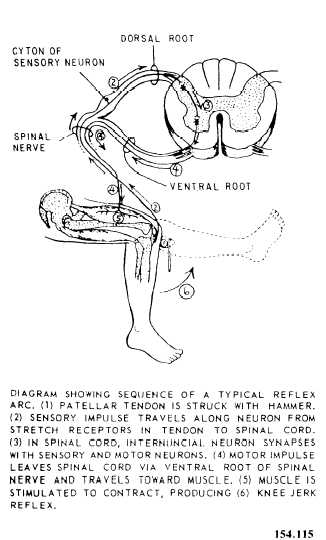A cross section of the spinal cord shows white and gray matter (fig. 3-43). The outer white matter is composed of bundles of myelinated nerve fibers arranged in functionally specialized tracts. It establishes motor communication between the brain and the body parts, The inner gray unmyelinated matter is shaped roughly like the letter H. It establishes sensory communication between the brain and the spinal nerves, conducting sensory impulses from the body parts. It also plays an integral role in the autonomic nervous system and in the reflex arc, both of which will be discussed later.
The spinal cord may be thought of as an electric cable containing many wires (nerves) that connect parts of the body with each other and with the brain. Sensations received by a sensory nerve are brought to the spinal cord, and the impulse is transferred either to the brain or to a motor nerve. The majority of impulses go to the brain for action. However, a system exists for quickly handling emergency situation. It is called the reflex arc.

Figure 3-43.—Cross section of the spinal cord and reflex arc.
If you touch a hot stove, you must remove the hand from the heat source immediately or the skin will burn very quickly. But the passage of a sense impulse to the brain and back again to a motor nerve takes time, The reflex arc is set up to respond instantaneously to emergency situations like the one just described. The sensation of hot travels to the spinal cord on a sensory nerve, where it is picked up by an interneuron in the gray matter, which triggers the appropriate nerve to stimulate a muscle reflex drawing the hand away. Another example of the reflex arc is shown in figure 3-43.
The reflex arc works well in simple situations requiring no action of the brain. Consider, however, what action is involved if the individual touching the stove pulls back and, in so doing, loses his or her balance and has to grab a chair to regain stability. Then the entire spinal cord is involved. Additional impulses must travel to the brain, then down to the muscles of the legs and arms to enable him or her to maintain balance and to hold on to a steadying object. While all this is going on, the stimulus is relayed through the sympathetic autonomic nerve fibers to the adrenal glands, causing adrenalin to flow, which stimulates heart action, and to the brain, making the individual conscious of pain. In this example the spinal cord has functioned not only as a center for spinal relaxes, but also as a conduction pathway for other areas of the spinal cord to the autonomic nervous system and to the brain.
PERIPHERAL NERVOUS SYSTEM
The peripheral nervous system is made up of 12 pairs of cranial nerves and 31 pairs of spinal nerves arising from the brain and spinal cord, respectively. These nerves carry both voluntary and involuntary impulses (fig. 3-44).
Cranial Nerves
The 12 pairs of cranial nerves are sensory, motor, or mixed (sensory and motor).
